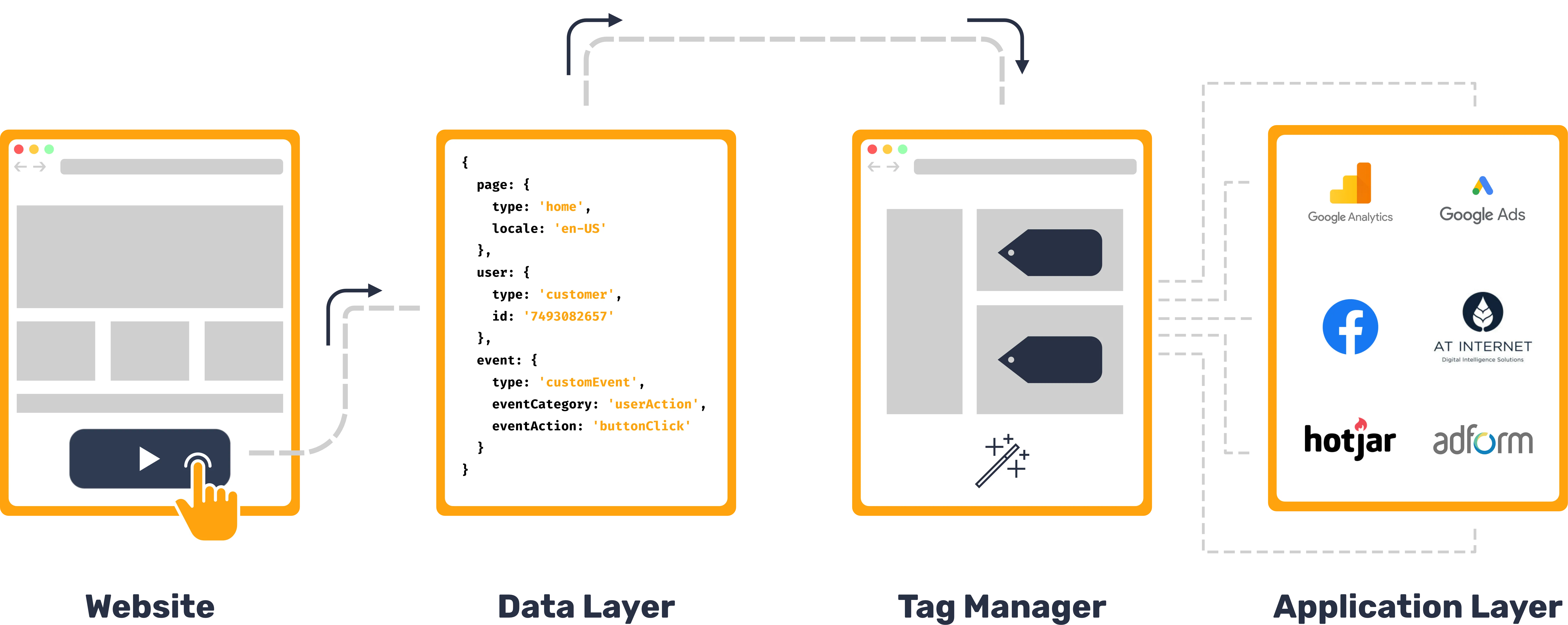Zoom in on Measurement Hub
Published: Jun 25th 2020 | 16 min read

Table of contents
Introduction
The process for better customer experience and personalization through improved segmentation starts with data collection of customers' journeys and interactions. In order to achieve the best possible outcomes, it is necessary to collect the data uniformly and set meaningful measurements across various platforms.
When all marketing and analytical platforms are dependent on the website data, the accuracy of data and its right integration are of the utmost importance. Leveraging the collected data is a competitive advantage that generates exponentially higher marketing investment returns.
In a perfect scenario, the company has reliable, responsive, and reasonably-priced development resources, the development team is highly skilled, continually cooperates with the SEO and marketing team, or there is an affordable third-party partner. But very frequently that is not the case. The task of high-quality data collected, analyzed, and measured can be vastly complex.
What is Measurement Hub
Measurement Hub is not just a box solution, rather a group of complex scripts, yet elevated, more powerful, and more robust deployed via Tag Management System (TMS), commonly used one is Google Tag Manager (GTM). The codes are verified and are standardly pre-defined, can be slightly adjusted, or in case of a complicated case, they can be deeply overhauled. In addition to the scripts, it includes definitions of events and entities for data layer specification. The specification of the data layer is customizable to fit every specific need of every company in order to reach desirable goals. Fully implemented with an omnichannel context, Measurement Hub is dynamic, happening on the user's browser. The data is flowing through; however, it can be stored with integrated data storage. Therefore, Measurement Hub's value is not embedded in the codes only, but also in the expertise of consultancy.
Simply, Measurement Hub consists of a data layer on the front continuing to tag management system reading, consuming, and distributing the data, including establishing accurate measuring into marketing and analytical platforms. Similar to TMS implementation but much more extended.

What Measurement Hub covers?
- Data layer specification (specification of entities, parameters of entities, events)
- Measurement specification (specification of mapping Data Layer into marketing and analytics platforms)
- Code for all commonly used marketing and analytics platforms (codes which will be implemented into TMS)
- Settings of an analytic platform
Maintenance and support
After the implementation, standardly you are fully independent, the code is under your ownership in your TMS. We provide an introductory explanation of the configuration and the specification is handed over in an editable document as well. Upon request, we can provide further consultations. We can also manage the Measurement hub and TMS for you.
What Measurement Hub does not cover?
Measurement Hub doesn’t focus on settings in marketing platforms. After the implementation of Measurement Hub, management of these marketing platforms is done on the company's side or their agencies, but we can help with that. At least there will be measurement specifications for the platform administrator to see what exactly is sent there. In case of additional questions or advice, we provide consultations for the standard hourly rate.
Why is its implementation essential
Just naming a few of the many advantages of Measurement Hub, the emphasis lays on data layer specification creating the foundation for the rest of the measurement.
Data layer specification
Fulfillment of Measurement Hub provides numerous advantages; however, the most valuable one is data layer specification, which imposes data consistency throughout the entire data flow to/from/in all the platforms, marketing, and analytical.
A well-constructed data layer (DL) can portray a roadmap to customer communication since thinking beforehand about customer interaction data supports its definition in order to connect all applications.
Making the data clean and consistent fastens the process and makes it more precise. Measurement Hub offers its own standard, which can fit any case. The specification of DL is customized for the individual needs ensuring the pre-defined requirements will be measured accurately everywhere.
Data layer specification is crucial for setting up website independence. Often, during website implementation, the data layer gets lost or broken and the measurement with it. The specification helps to discover it is broken and guides the development to fix it correctly. Additionally, the specification within Measurement Hub brings a conceptual solution and when done right from the beginning, it prevents the unnecessary failures of gradual implementation. It serves as a general overview and clear explanation of data layer events and what the data represents for the analysts.
Without the specification, the quality of the data cannot be validated with such accuracy and newcomers have nothing to understand of your data layer. To elaborate, the specification serves as a detailed manual not only for the development team but also helps your new team members to understand your data layer and measurement. It is better to show the actual documentation and explain the process in practice, than trying to describe it abstractly. From the experience, we observed it is a very handful in case you are expanding your team or there is a sudden change in staff.
Measurement specification
Mapping of entire data flow within the data infrastructure, from the data layer to each platform is important for analysts, performance teams, online marketing teams, marketing agencies, etc. Knowing what transfers where contributes not only to a better overview and a general understanding of the process, but it can set a foundation for better decisions in, for instance, marketing or business strategy, and unlocks new opportunities.
Validation
Part of the Measurement Hub implementation is a well-coordinated multilevel validation process which is done by our team of specialists who are well trained for this purpose. But there are also several tools, which are helping to reveal some errors in implementation automatically or just leverage effectiveness. Most of these tools were created by the Measurement Hub team itself for these purposes.
Among other advantages are:
- Utilizing the full potential of marketing platforms
- Easier implementation of custom tracking
- Easy control & well-manageable code of measuring
- Complex and conceptual measuring into an analytical platform
- Reliable and uniform measuring of (clean) data
- Automatic error tracking
- Fast and easy integration of new platforms
Common problems when not having Measurement Hub (or when do you need it)
Often, the question of what is behind Measurement Hub implementation, especially in the case of a bigger e-commerce website, when setting up TMS can be done internally. This is true, however, the advantage is not solely in TMS itself. TMS is a means to an end, which in this case can be better user segmentation, targeting, and consistent data structure that supports it all. It requires technical background and knowledge along with business and user understanding to be able to adjust the settings for current and future marketing purposes; to be able to think ahead and from a certain perspective.
Incorrect data: duplicity, different formats, unstructured, missing data...
Measurement Hub provides a set of codes that are implemented into TMS to make the most out of it but consistently and without duplicity. Without Measurement Hub the data is pushed in different formats causing duplicity or lost information. It can be almost impossible to put it all together after it is being pushed incorrectly.
Website design changes
If website content changes progressively, the data layer gets disrupted or disappears totally and the measurement in the analytical platform cracks and then becomes incorrect, absent, or delayed, requiring substantial changes in settings. Thanks to Measurement Hub's automatic error tracking, the broken data layer is detected on time, can be fixed without a delay and the data damage will be minimal.
One-time help but not bringing long-term impact
An easy and fast solution for a one-time project is not helping the company to grow. Opting for faster and simpler box solutions for smaller problems can help with the project. Measurement Hub looks at the whole picture, understanding the goal of the project and taking into consideration company growth. The elaborate conceptual approach harvests much more benefits in the long run and solves many problems.
Replacing platform
In case of a need of replacing any current platform (especially analytical) for the new one, the entire measurement can be significantly damaged. Many platforms have their own standard data layer that is developed for their own use but is not compatible with the other platforms. Therefore, its change is extremely difficult and lots of data gets lost in the process. Leveraging Measurement Hub's own data layer, which is flexible and vendor-agnostic, the substitution happens smoothly without interruptions.
Change in the platform API
Measurement Hub has its own DL standards that work for many different analytical and marketing platforms, are very flexible towards specific platforms and their changes. It is the first one to know when there is a change in the API of each platform.
Consent management ready
With the personal data law enforcement, customer consent needs to be integrated transversally on the entire website. Most TMS lack this extension, especially with GTM it can be almost impossible to execute. Measurement Hub is ready for any Consent Management System, the most common we use is Wecoma, which is in compliance with personal data protection laws, such as GDPR in the EU or CCPA in the US, or any other regulation.
What can be achieved
The ultimate reason for choosing Measurement Hub is generally improved marketing strategy achieved by:
- campaign automation and triggering
- better customer experience and personalization
- advanced segmentation and micro-segmentation
- managing marketing audiences for targeting and retargeting
- competitive advantage
- exponentially higher marketing investment returns
Why it's different
On top of all the benefits named above, Measurement Hub and the team executing it solve problems holistically for the company, not for one project. Experiences showed that the conceptual approach should not be forsaken for the seemingly longer execution on the contrary it needs to be prioritized.
Every third-party analytical and marketing tool has a different way of sending and collecting data, as well as different expectations on when and where their tags should be placed. We understand each platform and its parameters hence we know exactly how to implement them all properly. Measurement Hub is created to match the parameters therefore platform integration is simple and preserves data consistency.
The service also contains a detailed explanation of the whole process precise definitions of tailored requirements, documentation, and consulting.
Who can benefit
Website data measuring is important for every e-commerce company. However, when e-commerce is the core business or brings the most lead and marketing spending is quite significant, simple measuring and analysis are usually not sufficient. Eloquently big companies with complicated and extensive website data architecture tend to neglect the importance of consistency and structure. Reaching higher levels of personalization and accomplishing better marketing campaign results might take even more effort and resources when done manually. Just shaping it together along the way may seem adequate, in the short-term, but eventually, it will catch up later.
How does it work
Measurement Hub’s logic in TMS serves its purpose as a middleman between the website and each platform. Some key properties of Measurement Hub:
- It is running in the browser of a user visiting your web. Therefore, there is no need for any other server and infrastructure.
- It functions as a real-time stream middleman, thus by itself, it has no database or any storage.
In general, Measurement Hub takes the data from the data layer in real-time, transforms, and augments them, and immediately sends them into marketing and analytical platforms.
The whole data flow proceeds as follows:
- Main entities are pushed into the data layer
- User – information about the user
- Page – information about the context
- Session – information about the current session
- Order – information about things which user just ordered
- And so on...
- Event is pushed into the data layer
- Page – it tells us that pageview happened (but it could be also any other event e.g. Add to cart, Product like, etc.)
{
"page": {
"type": "list",
"trail": "marketing/articles",
"list": {
"pageNumber": 2,
"filters": {
"years": ["2020", "2019"],
"keywords": ["affilates", "seo"]
}
},
"locale": "cs-CZ",
"currencyCode": "CZK",
"countryCode": "CZ"
},
"session": {
"machine": "external",
"deviceType": "mobile",
"env": "prod"
},
"user": {
"username": "tester123",
"id": "66oc39119520732e1s1f23ead6c57",
"segment": "customer.premium",
"transactionCount": 2,
"transactionValue": 799.99
},
"event": "page"
}
- When some event is pushed into DL, logic in TMS is triggered and starts consuming all data in DL.
- First data are transformed and augmented if needed.
- Then logic for every marketing and analytics platform is triggered and data are transformed and send according to the platform's requirements.
- Data is processed and saved on servers of specific platforms
How is it implemented
The process starts with the definition of project requirements and is finalized by the implementation of measurement into platforms and proper settings of the analytic platform. The biggest and most important part is revolved around the data layer, its specification, implementation, and validation.
The implementation process of Measurement Hub consists of a series of steps and may take from a few weeks to several months, depending on the project requirements.
Implementation process in steps:
- Consultation on the measurement requirements with the client
- This is the phase where we need to gain knowledge of your business and understand your needs. The main measurement concept is created, and critical parts of the measurement are identified. It will define data requirements in marketing and analytics platforms on a general level.
- The requirements are specified by the Measurement Hub team together with a responsible person from your company, usually from the analytical team or performance team.
- Creating the data layer specification based on the client’s requirements and website structure
- This is the main part of the process. Every entity and every parameter, which could appear in Data Layer, must be properly defined. All events must be defined there.
- It is processed mainly by the Measurement Hub team but with a consultancy with your team.
- Specification adjustment with web development
- There is a difference between what an analytics or performance team wants, and how difficult it would be to implement it, if it is even possible and last but not least, how much it would cost. At this stage, developers can alert us to parts of the specification that would be too difficult to implement or that do not logically match, for example, the database structure of the website. The Measurement Hub team then incorporates the decision into the specification.
- Data layer implementation
- In this phase, the client's developers must implement the whole DL according to specifications.
- Data layer validation
- The data layer is validated manually by the Measurement Hub team. We are checking if events are happening when they should happen and if all parameters are containing what the specification defines. If there is some bug in the implementation, we are giving it back to developers for a fix.)
- Implementation of the codes into the preferred tag management system
- Measurement Hub team will implement the content of the tag management system with codes for all marketing and analytics platforms which client want to use according to measurement specification)
- Analytical platform settings
- Measurement Hub team prepares full settings of Analytical platform according to measurement specification, including custom dimensions, metrics settings, proper account structure settings, proper campaign grouping, filtering out testing, bots and other not wanted traffic.
- Validation of measured data in the analytical platform
- Measurement Hub team validates measured data in analytical data to approve the right implementation of everything above. Also, some errors in DL there could appear due to hidden parts of the web or use case, which was not possible to find out with manual validation.
Price
Measurement Hub's price depends on the website’s complexity, a number of marketing and analytics platforms, and individual requirements. Price ranges widely and it needs to be individually defined. There is a one-time payment just for the implementation without further fee for using Measurement Hub. Additionally, we can agree on a support fee for change requests in the specification, measurement codes, and so on.
FAQ
What if we do not have any tag management system?
That is not an obstacle. We can help you to pick the right one for you and include its implementation into the specification for developers.
Does Measurement Hub also work for mobile applications?
Yes, from a technical point of view it is different, but the concept is almost the same. There is just one main difference in the implementation process - the implementation of marketing and analytics platforms. In the application, the implementation needs to be done fully by your developers. However, we provide full specifications on how to implement Measurement Hub in the mobile application, consistently aligned with website measurement.
What if we have already implemented something in our TMS?
That is not a problem. We can choose from several approaches, depending on the quality of the content of your current TMS and your preferences. We can investigate the functionality in your current TMS and propose solutions for improvement. A few options that can be either use part of it or all of it, or just overwrite it all.
What if our developers do not cooperate, they are overloaded with other higher priority tasks, or they cannot help us for a different reason?
This can be a huge complication, which will definitely have an impact on the quality of the result. But we can help even in this case. It is possible to detect many things directly in TMS without developers' DL, which means without developers' help. We can develop some workarounds that can help you to get as much as possible from your website without developers.
What if I already have implemented the data layer?
We always prefer to create a new property for the new data layer to not be in conflict with the old one. The best practice is to also create a new TMS container for Measurement Hub and in that case, we have totally separated the old and the new measurement.
What about the continuality of my data?
We are always preparing the specification with respect to your current measurement. We are discussing with you where we can break continuality for better measurement usability and the final decision is always on you.


